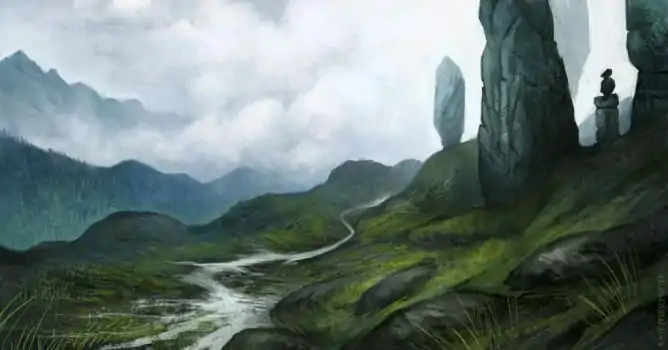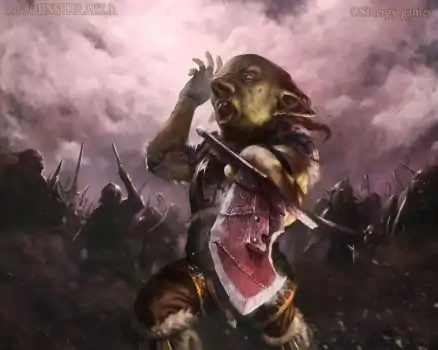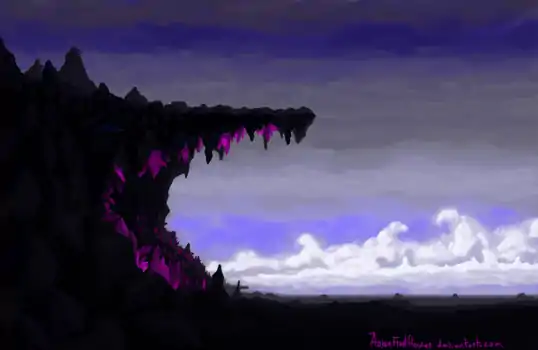Lowlands of Hundon (3.5e Environment)
General
 |
|---|
| Mornmist dissipates, and reveals the rugged beauty of Hundon. |
The rocky, hill-dominated expanse of land that lies between Redford and Caragos Eavorn is called the Lowlands of Hundon. The name might seem a bit weird at a first glance, considering the area is anything but low, but it is a double reference: the land is low compared to the high peaks that rise to the skies just north of it, and low in what the rest of the west would call culture.
In the relative orderliness of the southwestern part of Pansaer, Hundon stands out as a rough, even savage area, and it certainly could be seen as such. Asides from a handful of mining and lumber communities (mostly along the Raventurn), there are no permanent settlements here. The folk of the land, consisting of goblin tribes and wandering bandits, are rarely gifted builders, and in any case the uneven ground and dangerous wilds mean that buildings would get torn down more often than not.
But Hundon isn't without beauty, even if it lacks the comforts of civilization. The natural, raw feel and freedom of the place attracts travelers from surprisingly far, and (well-guarded) nobles from Redford come to the lowlands to hunt. Hundon is especially well-loved by botanists and entomologists, as the hills and veils are bursting with flower and insect life.
The northernmost hills of Hundon turn seamlessly into the mountains of Eavorn, and the dwarven mountain of Carag Vorn leaves the lowlands in its shade. The busy trade routes that run between Carag Vorn and the rest of the west don't pass through the lowlands themselves, however, but rather circle the area from the east, through the fortress of Hundonstone. The lowlands are also a land of rivers, many of them as wild and white-water as they come. Raventurn, the largest river in the west, has its source in the lowlands instead of the mountains proper, and is a roaring rapid before it calms into the lazy thoroughfare that the rest of the west knows it as.
Weather
The lowlands are fairly mundane when it comes to geography and weather. You'd be hard-pressed to find more stereotypical hills, with the only unique feature being the abundance of flowers both common and rare. The summers are warm, the winters are cold, the area experiences heavy rain and winds every now and then, and in general the nature of the area doesn't give people too much trouble. The inhabitants are another story.
The lowlands of Hundon are gentle hills terrain (DMG, p. 89) with pockets of medium forests (DMG, p. 87) scattered about. The hills are fairly uniform all through the area, with rugged hills only in the far north against the mountain range. The only geographical threat of note are the rivers: Hundon rapids are often narrow but surprisingly deep, and flow with terrible speed: most count as stormy waters (DMG, p. 92) and flow at a speed of around 50 to 70 feet per round.
Of the weather phenomenons of Hundon, only the mists are really worth mentioning - the rest is as normal for the region. The mornmist that fills the western lands when Auri's blazing forge rises from the Wasted Sea is, for reasons unknown, must heavier in Hundon than elsewhere. In general, the mornmist is a light haze except in the parts west of Caragos Maride, but in Hundon the mist is a thick fog (DMG, p. 94) for around half an hour every morning.
Wildlife
 |
|---|
| Tread on someone one too many times, and they might just tread back. |
The lowlands sport a variety of fauna typical to mountainous regions. Packs of wolves are common, and more aggressive than their plains cousins: some large packs are known to specifically target travelers, often led by bear-like alphas and in some cases wolves with frightfully knowing eyes. Local folklore speaks of a pack of intelligent, snow-white wolves that appear in the winter and drop the temperature where they hunt. Other animals consist of your typical mix of birds, bears, boars and so on. The ubiquitous insects of Hundon include some species that grow to outlandish sizes, including ants the size of wolves that build their towering ant formicaries in the southern parts of the lowlands.
The only humanoid race to live in the lowlands in large numbers are goblins. Many goblins have been driven out of the more civilized areas due to the racism their race faces in the west. This forces them to band together in tribes, and they grow hateful of the other races. Their underground holds wage minor wars against western villages and their hunters ambush travelers, and the hatred against their race deepens. Thus, a vicious cycle is born. Goblins are the only race to have permanent settlements in the lowlands, or under the lowlands to be more precise. The goblin forts (and they are invariably fortifications, not civilian settlements) are excavated into the earth or established in pre-existing caves to protect their inhabitants from the elements and the wildlife.
As a secluded region that's nonetheless close to many important locations, including Fort Brunid, Redford and Carag Vorn, Hundon has also always been a haven for those who want to harm the west as a whole. Cultists of various creeds hide here, as do twisted practitioners of magic and fey creatures. One particularly powerful faction that threatens the west, the Great Claw, hides in the lowlands. Stragglers from Remoras prairie occasionally make their way through the Pass of Strands despite the dangers involved, and set themselves to terrorize the lowlands. Due to the harsh conditions of the north, they're often some of the meanest inhabitants of Hundon.
Hundon is also home to quite a few members of the giant races, although mostly ogres and ettins - the "nobler" giants stick to the mountains. Very few of the giants actually live in the lowlands, but come down from the mountains to hunt, forage and generally terrorize. During especially scarce years the lowlands turn far more dangerous, since the amount of giants in the area increases greatly.
| d% (Easy) | d% (Hard) | Encounter | Average EL |
|---|---|---|---|
| — | 01-10 | 1d3 Great Claw vandals, 1d6 Great Claw alchemists, 2d6 Great Claw warriors and 1 Great Claw ogre | 8 |
| — | 11-17 | 1d6 winter wolves | 8 |
| — | 18-25 | 1 barghest and 2d6 wolves | 7 |
| — | 26-32 | 1d3 corrupted witches | 7 |
| — | 33-41 | 1 Hecatian spellslinger and 1d6+2 giant spiders | 7 |
| — | 42-48 | 1d4 bee swarms | 6 |
| 01-06 | 49-56 | 1 giant ant queen, 1d4 giant ant soldiers and 1d6 giant ant workers migrating to a new anthill | 6 |
| 07-16 | 57-66 | 1 Great Claw taskmaster and 1d4+2 Great Claw warriors | 6 |
| 17-23 | 67-74 | 1 ettin | 6 |
| 24-30 | 75-82 | 1d4 foul half-breeds, one of which has magical pipes | 5 |
| 31-36 | 83-91 | 1 invisible arcane murderer (5th-level wizard) specializing in illusion | 5 |
| 37-43 | 92-100 | 1 living feculence | 5 |
| 44-52 | — | 1d4 goliath fishermen (3rd-level expert) armed with harpoons | 4 |
| 53-59 | — | 1d4 chokers | 4 |
| 60-68 | — | 2d6 bandits lying in ambush, armed with heavy crossbows and a swinging log trap | 4 |
| 69-74 | — | 1 giant eagle | 3 |
| 75-81 | — | 1 ettercap amidst a maze of webs | 3 |
| 82-87 | — | 1d3 river-spirits | 3 |
| 88-93 | — | 2d6 giant beetles | 2 |
| 94-100 | — | 1 wolverine | 2 |
Points of interest
Headwaters of Raventurn
The largest and most important river in the west is the Raventurn, a river that passes not one but two major trade cities on its way to Fathme Bay: Redford and Calimport. In those cities and their surroundings, Raventurn is known as a wide, peaceful river, and conjures up images of trade barges lazily drifting down the clear waters. But at its source, Raventurn is a powerful whitewater rapid, and nowhere is it stronger than at its source.
The headwaters of Raventurn begin just north of the heart of the lowlands - not in the mountains as many believe. The river bubbles up from a group of springs, flows down a series of waterfalls and picks up the pace, then speeds through the lowlands with frightening speed. Raventurn, like many other Hundon rivers, is not that wide, but it is deceptively deep. What's more, the churning river has a nasty habit of pulling those who fall into it underwater, due to curious currents (Swim DC 30 to avoid going under; DMG, p. 92).
The springs that make up the headwaters of Raventurn are also home to a coven of naiads, powerful protectors of bodies of water. They are attended to by their elemental companions, as well as their fey handmaidens. The bravest in Hundon, as well as those few outside the lowlands who know of them, sometimes travel to the headwaters to consult the naiads: they are powerful augurs.
Hundonstone
The fortress of Hundonstone lies some five to ten miles from the border of the lowlands, depending on where you consider the hills to begin. It was built to facilitate trade between the dwarven powerhouse of Carag Vorn and the rest of the west, especially the trade metropolis of Redford. The lowlands themselves would be far too dangerous to send caravans through, and going around the mountains would be incredibly expensive.
While it doesn't have the beauty of some of the greatest cities of the continent, Hundonstone is nonetheless a much nicer place than most fortresses tend to be. This can probably be traced back to the rarity of actual attacks against it: it's presence is enough to calm the nearby area enough for trade. The walls have stayed pristine and the inside of the fort unmolested. The more pessimistic claim that the fortress actually couldn't withstand a dedicated enemy, and is more an ornament. That's not to say the fortress isn't active in defending the area (through regular patrols) or that it hasn't been attacked (groups of bandits or giants sometimes grow foolishly brave) - just that its mettle hasn't truly been tested yet.
The fortress is constructed of hardy Carag Vorn stone by skilled craftsdwarves from that bastion, and it shows: everything in Hundonstone that's made of stone is of exceptional quality. The fortress is a classic quadrangular build. The inside is divided into the larger, military section for the fort's soldiers and its Lord General, and the smaller trade section, which houses traders and travelers of all sorts. The presence of professional dwarven soldiers (the best Vorn gold can buy) makes Hundonstone one of the most peaceful dwellings in the west. Goblins are not allowed within the fortress, an unpleasant point of pride for its inhabitants.
Wolf's Maw
 |
|---|
| The nearby landscape has been consumed by the Wolf. |
In the northwestern edge of the lowlands, the flower-speckled hills and roaring rivers turn into singed rock and muddied streams. Entire forests have been cut down, rivers dammed and rerouted, hills hewed flat with watchtowers in their stead. All this, to feed the endless gullet of Wolf's Maw, the underground headquarters of the Great Claw.
Skarrnog, the unchallenged lord of the wild goblins in Hundon, holds court in his rough castle. Wolf's Maw is excavated directly into the wall of one of the outermost mountains of Caragos Eavorn, and thus lies just between the mountains and the lowlands - although secret passageways lead to both areas. The entrance really is fashioned into a wolf with its jaws wide open, with the corpses of the Great Claw's enemies often impaled on the teeth. The quality of the monument is questionable, however, as is the rest of the architecture: goblins are skilled builders, but in the wilds without proper tools and artisans, the chances are sub-par.
Wolf's Maw is inhabited by throngs of wild goblins, organized into smaller groups, each of which is led by a boss. The place is cavernous, with haphazard stone staircases spiraling into the heights: goblins like their architecture tall. Balconies open in the mountainside and give a vista of all the surrounding lands. The lower basements house the more monstrous among Skarrnog's servants: giant spiders, offspring of Rakabarr and Urabarr, ettins, and other, even fouler "specialties".
Skarrnog's throne room is situated in a domed hall in the highest levels of Wolf's Maw. It is the only room in the fortress that could be considered gorgeous, albeit it is still on the rough side. Furs cover the floor (no wolf furs, though), tapestries hug the walls, and Skarrnog himself meets his minions on a throne fashioned of an ettin spine. A steel chandelier the size of a small house dangles from the ceiling, and on it one can just spy a small nest: it houses Izzit-Ogg when it's not jesting for its master.
Examples of adventures
- Burrow Into Hell: You go over a hill and are scant inches from plummeting into a deep chasm in the ground. It's not a natural hole: support beams have been put up against the walls, and the earth and stone bear marks of tools. In the deep, already a third of a mile into the earth, a group of raving fanatics are forcing their slaves to dig with whips and burning brands. The fanatics are servants of a powerful chthonic being who whispers into the ears of those who learn its true, secret name. It beckons them to the wilds, to dig a hole into the heart of the world to free it. Whether the creature is real or a figment of madness, it doesn't matter: the fanatics will soon seek to make you dig as well.
- Cold Morn: Dawn breaks in the lowlands, and Auri's thick mornmist envelops the hills as it does every morning. But something's different: when the mist snakes its way around you, you feel a weight coming over you. The mist is cold as ice and thick as molasses, and you quickly discover it can't be outran. Then you hear a screech. Something stalks you, unhindered by the fog.
- Hedged In: A stout unicorn, once the valiant protector of a sizable forest between two tall hills, has been driven mad. The forest has been cut down to a pathetic thicket by loggers and by goblins, and the mangy creature can do little but pace back and forth, eating poorly of the little that still grows in the forest. The beast attacks anyone who so much as comes near the trees, frothing at the mouth and neighing weakly. There is no saving it. The kindest thing a soul can give the unicorn is a swift death.
- Helplessly Lost: You happen upon a girl of no more than seven, sitting on a tree stump and crying. When calmed, she tells that she's one of the few children that live in a nearby logging camp; and she misses her mama, she can't stress that enough. When arriving at the camp, the loggers welcome you heartily - but the girl is nowhere to be seen! They tell you a chilling story: a bandit tried to kidnap one of the camp's few children for a ransom, but as the furious loggers hunted him through the nighttime woods, he ended up strangling the girl to silence her.
- Twice As Strong, Twice As Stupid: A particularly savage-looking ettin is sitting on top of an ornate chest in the middle of a small glade. He's a servant of the Great Claw, and was tasked with guarding the chest until backup could arrive with a cart: the chest is heavy as sin, since it is chock-full of taxation silver. The ettin is strong and equipped with two cruel-looking masterwork battleaxes, but also as stupid as the boar its heads resemble: it shouldn't be too hard to convince it that you're agents of the Great Claw yourselves. In fact, a particularly sly speaker can con the beast to attack the "imposters" who will later arrive to cart away the chest.
Back to Main Page → 3.5e Homebrew → Environments
Back to Main Page → 3.5e Homebrew → Campaign Settings → Years of Gold → Geography & Environment